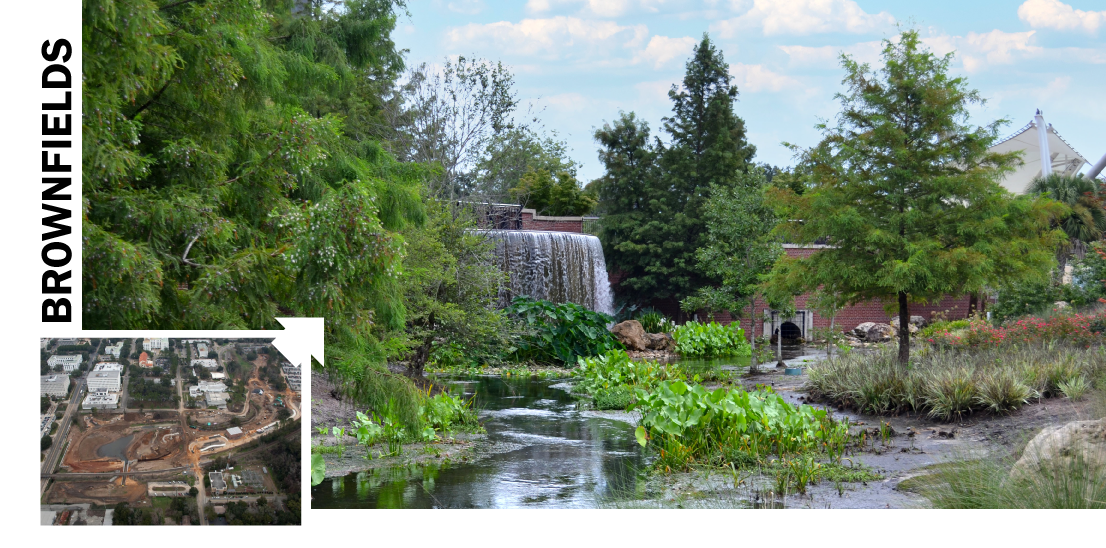
Download the Brownfields educational brochure.
The City's Brownfields program is recognized as one of the most successful in the state of Florida and southeastern United States and has received over $3 Million in grant funding from the United States Environmental Protection Agency (EPA) and Florida Department of Environmental Protection (FDEP) since 1997. Brownfields are properties where the presence or potential presence of environmental contamination hinders their redevelopment or reuse. Cleaning up and reinvesting in brownfield properties improves and protects the environment, facilitates job growth, utilizes existing infrastructure, increases the local tax base, and removes development pressures on undeveloped open land.
Through the City's Brownfields Program, we have completed environmental assessment and/or remediation on worthy projects throughout our community, cleaning up our environment and making way for economic development with an increased local tax base. At the 2019 National Brownfields Conference, the City of Tallahassee received an award for "greatest dollars leveraged" among cities with a population under 200,000.
The City's Environmental Services Department is responsible for administering the City's Brownfields Program. If you are interested in having a Phase I or Phase II Environmental Site Assessment performed on a property, complete the Site Suggestion Form and email it to: brownfields@talgov.com.
For more information about the City of Tallahassee's Brownfields Program, please contact:
Kelly Crain
Environmental Programs Coordinator
kelly.crain@talgov.com
850-891-8563
What are Brownfields?
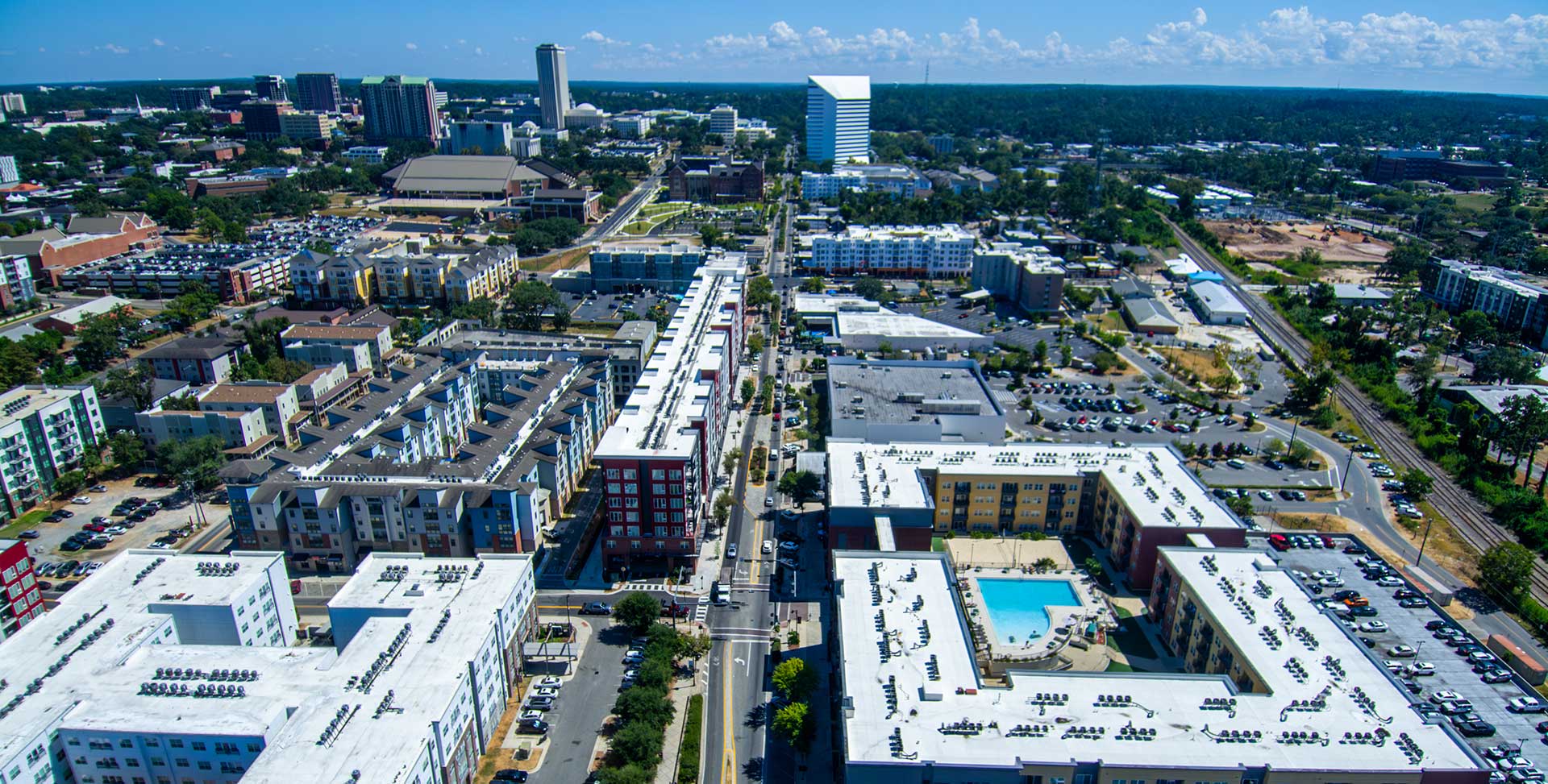
Brownfield Sites are defined as "real property, the expansion, redevelopment, or reuse of which may be complicated by actual or perceived environmental contamination."
Brownfield Areas are defined as "a contiguous area of one or more brownfield sites, some which may not be contaminated, and which has been designated by a local government by resolution. Such areas may include all or portions of community redevelopment areas, enterprise zones, empowerment zones, other such designated economically deprived communities and areas, and Environmental Protection Agency-designated brownfield pilot projects."
It is important to note that brownfield sites and brownfield areas are not necessarily contaminated. Industrial or underutilized properties are often perceived as contaminated, however, whether the site or area is contaminated cannot be determined until some form of environmental investigation is undertaken. Confirming the absence of contamination can help pave the way for potential redevelopment efforts. Conversely, should contamination be detected, property owners may be eligible to take advantage of the incentives the Brownfields Program has to offer.
The Florida Legislature enacted the Brownfields Redevelopment Act in 1997 to reduce public health and environmental hazards on commercial and industrial sites that are abandoned or underused and to create financial and regulatory incentives to:
- Promote voluntary cleanup.
- Prevent the premature development of greenspace.
- Reduce public cost for installing infrastructure in greenspaces.
- Encourage the highest and best use of blighted properties.
- Minimize or eliminate the need for environmental enforcement or state-funded cleanup.
- Encourage community revitalization.
Designated Brownfield Areas
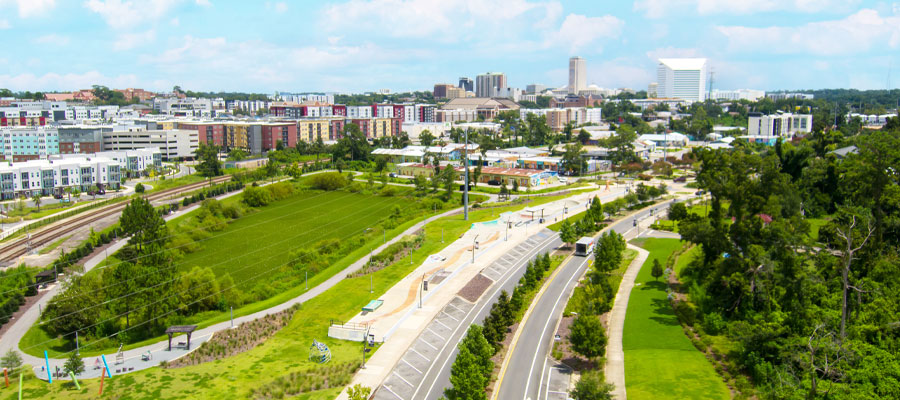
Brownfield Areas can be designated by local governments, through resolution, to incentivize redevelopment within those areas. A Brownfields Area designation is a tool that provides the community with access to state and federal incentives that allow environmental assessments and possible cleanup of properties. These designations pave the way for economic development through financial and regulatory incentives that encourage redevelopment of properties that are idle or blighted by perceived or actual contamination.
Gaines Street Corridor:
The City designated the Gaines Street Corridor (GSC) as a Brownfield Area in 2000. This local designation provided the necessary catalyst to spur redevelopment and voluntary cleanup in an underutilized area within the heart of the City. In 2008, the City received an EPA Assessment Grant for $400,000 to conduct environmental assessment work in the GSC, which encompasses approximately 440 acres. Building upon the success of the assessment grant, in 2009 the City was awarded three additional EPA Brownfields Cleanup Grants totaling $600,000. The City successfully implemented these cleanup grants on the following properties in order to enhance the overall Gaines Street development projects: GSC Infrastructure Project, CSX Properties, and Salie Property. The City later received a Revolving Loan Fund grant from EPA and used the funds to provide loans for site rehabilitation at the Former Arts Exchange Property, which is now the Hampton Inn, and the Former CSX 4 property which is now Stadium Enclave Student Housing. The GSC is a shining example of transformative redevelopment made possible by public and private partnerships and incentives provided through the Brownfields Program.
South Monroe Street Corridor:
Building on the successful redevelopment of the GSC, in April of 2016 the City designated the South Monroe Street Corridor Brownfields Area (SoMo), connecting the GSC, Cascades Park and South Monroe Street. Within the SoMo corridor there is legacy contamination from petroleum, drycleaning solvents, and other hazardous waste sites. The designation provides opportunities for eligible property owners to take advantage of program benefits such as tax credits, job creation incentives, and streamlined environmental permitting.
Airport Gateway Corridor:
The City designated a portion of Lake Bradford Road, Orange Avenue, and Springhill Road as a Brownfield Area known as the Airport Gateway Corridor in 2023. The Airport Gateway Corridor joins the successfully redeveloped GSC and expands the focus to include the commercial property situated along or proximate to portions of Lake Bradford Road, Orange Avenue, Springhill Road, and Capital Circle. Designating this area as a state Brownfield Area increases opportunities for investment in our community to drive the economic development of this area which has great potential. The area also includes approximately 118 acres of limited recreational open space.
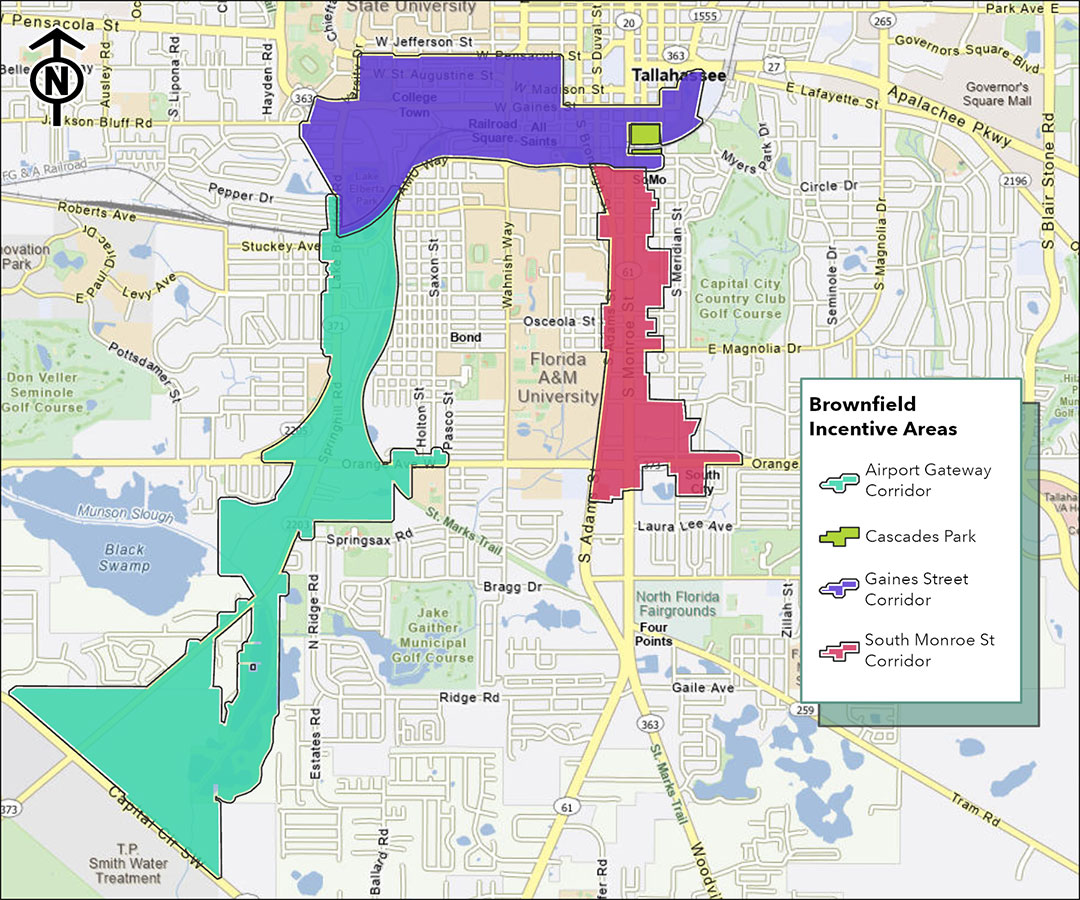
City of Tallahassee Brownfields Assessment Grant
In addition to the incentives available through the state's Brownfields Program, EPA also provides grants and technical assistance to communities for brownfields assessments and cleanups. The City has received multiple grants, totaling over $3 million since inception of the program. The City has engaged and completed assessment and/or remediation at over 40 projects within Tallahassee, cleaning up our environment and making way for economic development.
In 2022, the City was awarded a Brownfields Assessment Grant of $500,000 from EPA. The grant funds will be used to conduct environmental assessments within our community. These grant funds are eligible for anyone to utilize to conduct a Phase I and/or Phase II Environmental Site Assessment (ESA). ESAs are commonly performed for due diligence for property transactions.
In addition to Phase I and II ESAs, funding for this program can cover a variety of other initiatives, including a range of planning activities, such as developing site-specific cleanup plans and community engagement related to brownfield sites.
State Brownfields Program Incentives
FDEP oversees Florida's Brownfields Program and provides financial and regulatory incentives for eligible sites
State Financial Incentives:
- Voluntary Cleanup Tax Credits (VCTC): tax credits are awarded to partially offset the cost of rehabilitation or solid waste removal. Additional "bonuses" are available for affordable housing and healthcare facility redevelopment projects.
- Job Bonus Tax Refund: Approved applicants receive tax refunds up to $2,500 for each job created.
- Sales Tax Refund: Refund on sales tax paid on the purchase of building materials used for affordable or mixed-use housing projects.
State Regulatory Incentives:
- Liability protection
- Expedited technical review.
- Technical assistance
- State and Tribal Response Program: federal grant funding given to FDEP that the state can use to provide direct assistance to communities for assessment and cleanup services.
Success Stories
Stadium Enclave:
The Stadium Enclave is a student housing facility located within the Gaines Street Corridor. The land for the Stadium Enclave portion of the project is an assemblage of multiple parcels, which included the former CEMEX concrete batch plant and a portion of a CSX railroad, referred to as CSX Parcel 4. Under the City's Brownfields Program, assessments were performed at various parcels within the Gaines Street Corridor, including former CSX Parcel 4. The City approved a RLF loan to Stadium Enclave to remove and remediate contaminated soils associated with CSX Parcel 4. In addition to the student housing facility, the western portion of the property has been incorporated into the St. Marks Trail, a bike and hiking trail connecting Tallahassee to the City of St. Marks.
Cascades Park:
The Cascade Park Coal Gasification Plant/Cascade Landfill site was designated as the City's first Brownfield Area in 2000. Operations of the manufactured gas plant and landfill caused contamination of soil and groundwater. The City's herculean environmental rehabilitation efforts at Cascades Park, combined with the City's designation of the site and adjacent streets as Brownfield Areas, resulted in the successful cleanup and redevelopment of Cascades Park and the surrounding downtown properties. In 2008, the City was awarded EPA Region 4's first ever, "Excellence in Site Reuse" award. According to EPA, this honor is given to those who go above and beyond in their Superfund site redevelopment efforts. The redevelopment of Cascades Park spurred development around the perimeter of the park, providing residential, retail, office, restaurant, and hotel space to the area, making Cascades Park an area to live, work and play. Cascades Park is designed to be a "floodable park"; during major storm events, it provides flood relief to nearly 1,480 acres of drainage areas north and south of the site. The park features a network of underground channels, open streams, and retention ponds. The revitalized Cascades Park opened to the public in 2014. The project attracts $400 million in private sector investment around Gaines Street, and the economic impact continues to grow today.


Independence Landing:
Independence Landing is a safe, affordable residential community for adults with varying intellectual and/or developmental disabilities. Adjacent to a city bus stop and city park, residents have access to the greater City of Tallahassee and its offerings. The Southwood community provides amenities within walking and biking distance including doctor offices, restaurants, grocery and drug stores, and a multitude of potential job work sites. The City's Brownfields Program provided grant funds to perform a Phase I Environmental Site Assessment for the property in 2020. The Phase I did not identify any environmental concerns and is a great example of how Brownfields grants can be used to facilitate redevelopment by ruling out environmental concerns.

Residence Inn:
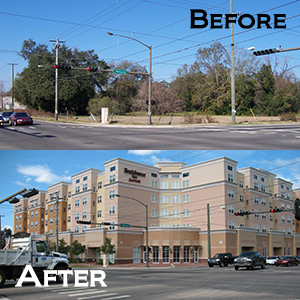 The Residence Inn on Gaines Street was one of the City's first brownfield sites to be cleaned up under the State's Brownfields Program. Contamination occurred as a result of historical operations on the property including petroleum service stations, bulk oil storage and other industrial uses. Through use of brownfields grant funds and the incentives provided by the State's Brownfields Program, the site was assessed and remediated. The Residence Inn was constructed and opened for business in 2006.
The Residence Inn on Gaines Street was one of the City's first brownfield sites to be cleaned up under the State's Brownfields Program. Contamination occurred as a result of historical operations on the property including petroleum service stations, bulk oil storage and other industrial uses. Through use of brownfields grant funds and the incentives provided by the State's Brownfields Program, the site was assessed and remediated. The Residence Inn was constructed and opened for business in 2006.
Hyatt House:
Prior to construction of the Hyatt House located at the corner of Railroad Ave and McDonnell Drive, this property was idle and underutilized. City Brownfields grant funds were used to perform Phase I and Phase II Environmental Site Assessments due to the historical industrial use of the area and surrounding properties. The hotel was constructed in 2020 providing much needed accommodations for the area attractions including the vibrant Railroad Square Art District, FSU Stadium, Donald L. Tucker Civic Center, and Downtown Tallahassee.
Resources
FDEP's Brownfields Program
FDEP's VCTC Program
FDEP's Brownfields Map
EPA's Brownfields Program
EPA Brownfields Grants and Funding
Cascades Park EPA Case Study
Site Suggestion Form